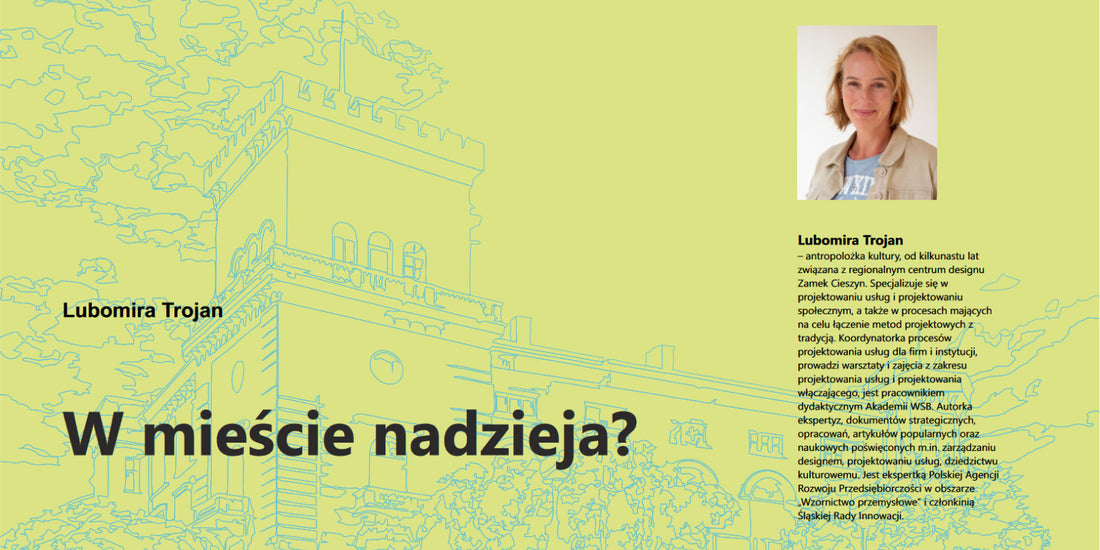
Hope in the city?
Until recently, many social scientists predicted that by 2050, up to 75% of the world's population would live in cities. The pandemic has led some people to reconsider their views on cities as the best place to live, but they are still considered more attractive in terms of access to work, culture, education, and healthcare. Migration toward cities will undoubtedly continue, and it is becoming imperative to prepare urban spaces and urban systems for constant change and residents' expectations.
One of the tools that enables us to better cope with change is design, particularly systemic and social design, which responds to social challenges. In the 21st century, design has acquired a distinctive character, its overarching characteristic being the use of a set of interdisciplinary methods and tools. Their application facilitates responding to human needs in a manner that is most appropriate to them.
This approach increasingly guides urban activities undertaken by city activists, designers, representatives of the creative sector, and city officials themselves. One example of a process that required a rapid response to a major social problem and utilized a design approach is the one conducted several years ago in Cieszyn. The city was undergoing construction of an integrated transfer hub and bus station. This caused significant disruptions for travelers using temporary bus stops located on a narrow street and near apartment buildings. It also resulted in heavy traffic, noise, and exhaust fumes, which residents protested. As a result, a conflict erupted between the city's decision-makers, who had chosen this location, and the residents. To resolve the conflict, it was decided to relocate the temporary bus hub to a parking lot near Cieszyn Castle. Cieszyn Castle is a regional design center whose mission is to promote design and design methods in creating higher-quality products and services. In order to avoid repeating the mistakes made earlier and to ensure residents' comfort while traveling, it was decided to use design methods and transform the problem into a design challenge.
This was facilitated by the project "Human Cities. Challenging the City Scale 2014-2018," which was underway at the time and aimed to conduct experimental activities in urban spaces in collaboration with designers.
The fundamental principle of the adopted working method was observing and addressing people's needs. Responding to genuine expectations increases the chances of building a "humane" city, where residents' voices and participation matter. Representatives of the Human Cities team from Cieszyn Castle and the designers were involved in the process of organizing the temporary bus station. Representatives of the university (WSB Academy) were also invited, and students conducted surveys on local transport demand. Collaboration with a large group of stakeholders was valuable: representatives of local government, transport companies, passengers of various ages and professions, small local businesses, and others. These individuals were interviewed, their needs and role in the broader local transport system were assessed.

The main design challenge was defined as helping travelers navigate the chaos, lack of information, and comfort resulting from the shifting bus stop locations. It was assumed that both bus operators and snack vendors are equally important in the system, and that comfort comes from being able to quickly buy a ticket or read a book while waiting for a bus.

The first important element of the process was designing visual communication for the temporary station. A new graphic design for the timetable and a temporary city information system were created, taking into account access to the station for residents from various districts, people traveling from the entire county, and travelers from the nearby Czech Republic. The next step was to take care of the surroundings of the stops. Simple furniture was created, made from recycled materials, allowing both seniors and school groups to relax. In addition to flowers, books were placed at the stops, and the bus shelters themselves were covered with graphics depicting important figures in the city. The goal was to make the place more "human," one that "speaks" about the city, builds its image, and where residents and travelers alike feel good. The design approach, the effort to consider people's needs, and simple and inexpensive solutions effectively improved the experience of using the stop. Proof of this success was the fact that travelers even pitched a tent between stops and spent the night there, finding the place pleasant and friendly.

Thanks to extensive collaboration and a recognition of human needs, the problem was transformed into an opportunity for the city to improve the quality of services offered. The knowledge and experience gained during this process were retained and continued in the subsequent design of a permanent station and a permanent city information system for tourists and residents.

Lubomira Trojan
A cultural anthropologist who has been associated with the Cieszyn Castle regional design center for over a decade . She specializes in service design and social design, as well as in processes aimed at combining design methods with tradition. She coordinates service design processes for companies and institutions, conducts workshops and classes on service design and inclusive design, and is a teaching fellow at the WSB University. She has authored expert opinions, strategic documents, studies, and popular and scholarly articles on topics such as design management, service design, and cultural heritage. She is an expert for the Polish Agency for Enterprise Development in the area of "Industrial Design" and a member of the Silesian Innovation Council.
